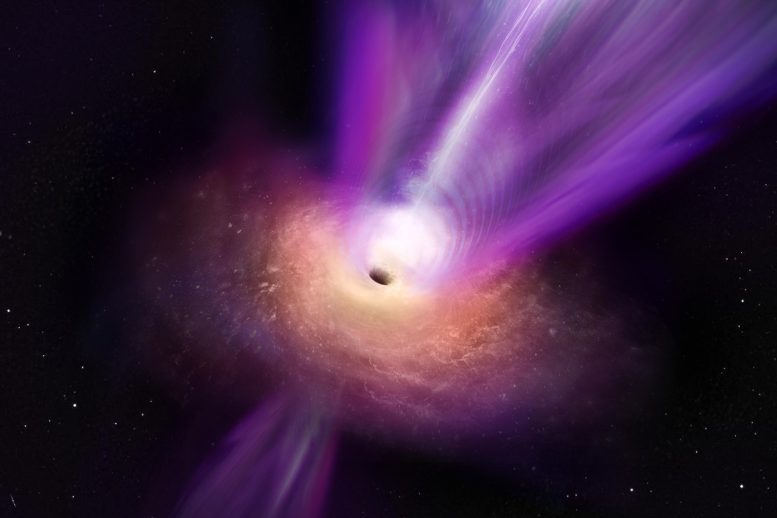
This artist’s conception shows a close-up view to the accretion flow and the jet emerging from black hole region in Messier 87. Researchers at the Shanghai Astronomical Observatory have taken a panoramic image of a black hole and its jet in Messier 87 (M87) at a new 3.5 mm wavelength. The image, captured with the help of ALMA and GLT telescopes, has improved resolution and sensitivity, allowing for better understanding of the surrounding material, known as accretion, and the ring-like structure of the black hole. Credit: S. Dagnello (NRAO/AUI/NSF)
A panoramic image of the M87 black hole and its jet has been captured at a new 3.5 mm wavelength, revealing more details about the surrounding material and ring-like structure. Surprising findings suggest possible winds causing turbulence around the black hole. Future observations will study its time evolution and provide multi-color radio light images.
“Previously we had seen both the black hole and the jet in separate images, but now we have taken a panoramic picture of the black hole together with its jet at a new wavelength,” says Ru-Sen Lu, from the Shanghai Astronomical Observatory and leader of a Max Planck Research Group at the Chinese Academy of Sciences. The surrounding material is thought to fall into the black hole in a process known as accretion. But no one has ever imaged it directly. “The ring that we have seen before is becoming larger and thicker at 3.5 mm observing wavelength. This shows that the material falling into the black hole produces additional emission that is now observed in the new image. This gives us a more complete view of the physical processes acting near the black hole,” he added.
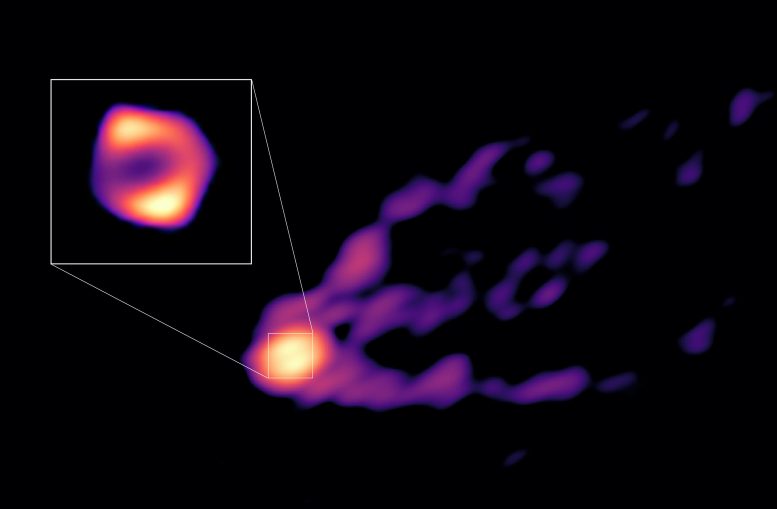
GMVA+ALMA image of the central black hole region in Messier 87 obtained on April 14-15, 2018 at a wavelength of 3.5 mm. The large image depicts the jet and central ring as reconstructed by the standard CLEAN method. The inset shows a magnification of the inner region obtained with the super-resolving SMILI method, revealing the ring shape with a diameter of 64 microarcseconds, which corresponds to 8.4 Schwarzschild radii. Credit: R.-S. Lu (SHAO), E. Ros (MPIfR), S. Dagnello (NRAO/AUI/NSF)
The participation of ALMA and GLT in the GMVA observations and the resulting increase in resolution and sensitivity of this intercontinental network of telescopes has made it possible to image the ring-like structure in M87 for the first time at the wavelength of 3.5 mm. The diameter of the ring measured by the GMVA is 64 microarcseconds, which corresponds to the size of a small (5-inch/13-cm) selfie ring light as seen by an astronaut on the Moon looking back at Earth. This diameter is 50 percent larger than what was seen in observations by the Event Horizon Telescope at 1.3 mm, in accordance with the expectations for the emission from relativistic plasma in this region.
“With the greatly improved imaging capabilities by adding ALMA and GLT into GMVA observations, we have gained a new perspective. We do indeed see the triple-ridged jet that we knew about from earlier VLBI observations,” says Thomas Krichbaum from the Max Planck Institute for Radio Astronomy (MPIfR) in Bonn. “But now we can see how the jet emerges from the emission ring around the central supermassive black hole and we can measure the ring diameter also at another (longer) wavelength.”
Animation showing how the EHT image of M87* combines with the image from the GMVA, where the central black hole can be seen together with the birth of the relativistic outflow. Credit: Ivan Marti-Vidal
The light from M87 is produced by the interplay between highly energetic electrons and magnetic fields, a phenomenon called synchrotron radiation. The new observations, at a wavelength of 3.5 mm, reveal more details about the location and energy of these electrons. They also tell us something about the nature of the black hole itself: it is not very hungry. It consumes matter at a low rate, converting only a small fraction of it into radiation. Keiichi Asada of Academia Sinica, Institute of Astronomy and Astrophysics explains: “To understand the physical origin of the bigger and thicker ring, we had to use computer simulations to test different scenarios. As a result, we concluded that the larger extent of the ring is associated with the accretion flow.”
Kazuhiro Hada from the National Astronomical Observatory of Japan adds: “We also find something surprising in our data: the radiation from the inner region close to the black hole is broader than we expected. This could mean that there is more than just gas falling in. There could also be a wind blowing out, causing turbulence and chaos around the black hole.”
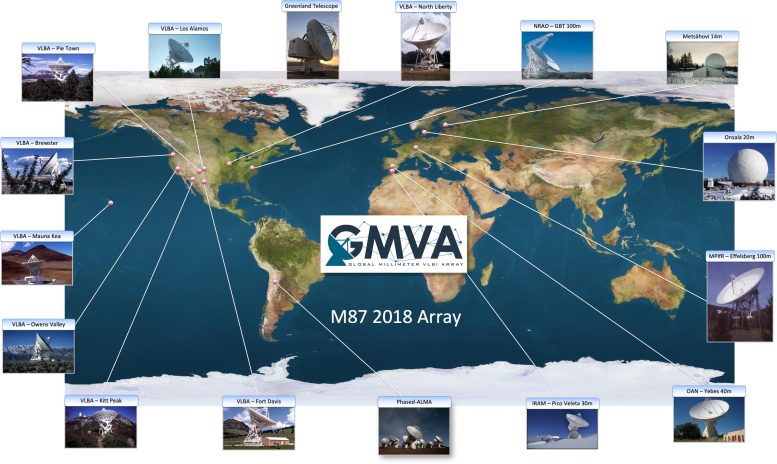
Map of the radio telescopes used to image Messier 87 at 3.5 millimetres in the 2018 Global Millimetre VLBI Array (GMVA) campaign. Credit: Helge Rottmann, MPIfR
The quest to learn more about Messier 87 is not over, as further observations and a fleet of powerful telescopes continue to unlock its secrets. “Future observations at millimeter wavelengths will study the time evolution of the M87 black hole and provide a poly-chromatic view of the black hole with multiple color images in radio light,” says Jongho Park of the Korea Astronomy and Space Science Institute.
This research has made use of data obtained with the Global Millimeter VLBI Array (GMVA), which consists of telescopes operated by the Max-Planck-Institut für Radioastronomie (MPIfR), Institut de Radioastronomie Millimétrique (IRAM), Onsala Space Observatory (OSO), Metsähovi Radio Observatory (MRO), Yebes, the Korean VLBI Network (KVN), the Green Bank Telescope (GBT) and the Very Long Baseline Array (VLBA).
For more on this discovery, see Historic First Direct Image of a Black Hole Emitting a Powerful Jet.
Reference: “A ring-like accretion structure in M87 connecting its black hole and jet” by Ru-Sen Lu, Keiichi Asada, Thomas P. Krichbaum, Jongho Park, Fumie Tazaki, Hung-Yi Pu, Masanori Nakamura, Andrei Lobanov, Kazuhiro Hada, Kazunori Akiyama, Jae-Young Kim, Ivan Marti-Vidal, José L. Gómez, Tomohisa Kawashima, Feng Yuan, Eduardo Ros, Walter Alef, Silke Britzen, Michael Bremer, Avery E. Broderick, Akihiro Doi, Gabriele Giovannini, Marcello Giroletti, Paul T. P. Ho, Mareki Honma, David H. Hughes, Makoto Inoue, Wu Jiang, Motoki Kino, Shoko Koyama, Michael Lindqvist, Jun Liu, Alan P. Marscher, Satoki Matsushita, Hiroshi Nagai, Helge Rottmann, Tuomas Savolainen, Karl-Friedrich Schuster, Zhi-Qiang Shen, Pablo de Vicente, R. Craig Walker, Hai Yang, J. Anton Zensus, Juan Carlos Algaba, Alexander Allardi, Uwe Bach, Ryan Berthold, Dan Bintley, Do-Young Byun, Carolina Casadio, Shu-Hao Chang, Chih-Cheng Chang, Song-Chu Chang, Chung-Chen Chen, Ming-Tang Chen, Ryan Chilson, Tim C. Chuter, John Conway, Geoffrey B. Crew, Jessica T. Dempsey, Sven Dornbusch, Aaron Faber, Per Friberg, Javier González García, Miguel Gómez Garrido, Chih-Chiang Han, Kuo-Chang Han, Yutaka Hasegawa, Ruben Herrero-Illana, Yau-De Huang, Chih-Wei L. Huang, Violette Impellizzeri, Homin Jiang, Hao Jinchi, Taehyun Jung, Juha Kallunki, Petri Kirves, Kimihiro Kimura, Jun Yi Koay, Patrick M. Koch, Carsten Kramer, Alex Kraus, Derek Kubo, Cheng-Yu Kuo, Chao-Te Li, Lupin Chun-Che Lin, Ching-Tang Liu, Kuan-Yu Liu, Wen-Ping Lo, Li-Ming Lu, Nicholas MacDonald, Pierre Martin-Cocher, Hugo Messias, Zheng Meyer-Zhao, Anthony Minter, Dhanya G. Nair, Hiroaki Nishioka, Timothy J. Norton, George Nystrom, Hideo Ogawa, Peter Oshiro, Nimesh A. Patel, Ue-Li Pen, Yurii Pidopryhora, Nicolas Pradel, Philippe A. Raffin, Ramprasad Rao, Ignacio Ruiz, Salvador Sanchez, Paul Shaw, William Snow, T. K. Sridharan, Ranjani Srinivasan, Belén Tercero, Pablo Torne, Efthalia Traianou, Jan Wagner, Craig Walther, Ta-Shun Wei, Jun Yang and Chen-Yu Yu, 26 April 2023, Nature.
DOI: 10.1038/s41586-023-05843-w
ALMA construction and operations are led by ESO on behalf of its Member States; by the National Radio Astronomy Observatory (NRAO), managed by Associated Universities, Inc. (AUI), on behalf of North America; and by the National Astronomical Observatory of Japan (NAOJ) on behalf of East Asia. The Joint ALMA Observatory (JAO) provides the unified leadership and management of the construction, commissioning and operation of ALMA.
The Greenland Telescope (GLT) retrofit, rebuild, and operation are led by the Academia Sinica, Institute of Astronomy and Astrophysics (ASIAA) and the Smithsonian Astrophysical Observatory (SAO).
The Green Bank Observatory (GBT) and the National Radio Astronomy Observatory (VLBA) are major facilities of the National Science Foundation, operated under cooperative agreement by Associated Universities, Inc.
The data were correlated at the Max Planck Institute for Radio Astronomy (MPIfR), which also operates the Global Millimeter-VLBI Array (GMVA).

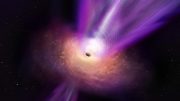
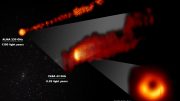
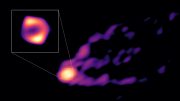


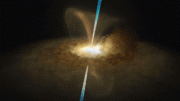

Be the first to comment on "Panoramic Peek: Black Hole and Powerful Jet Unveiled in Stunning Detail"